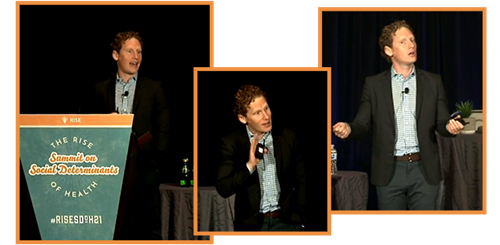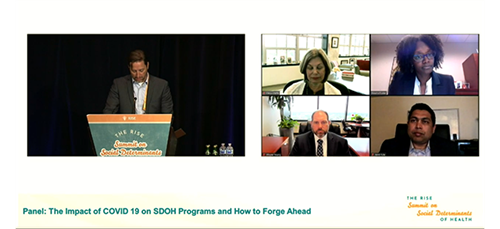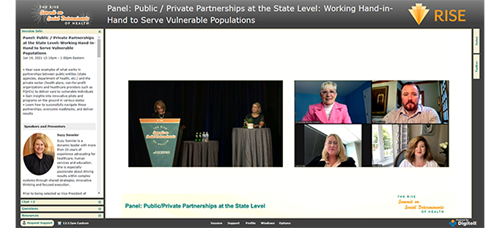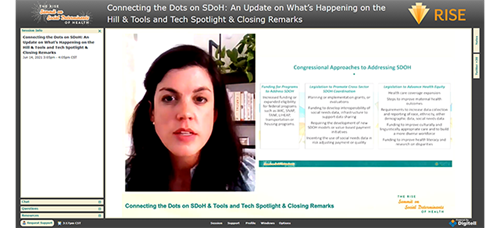It’s been a busy first day at The RISE Summit on Social Determinants of Health! After a long 16 months, many of us have experienced a thrilling return to in-person attendance in Nashville, and others joined from the comfort of their home offices thanks to our reimagined hybrid conference experience. It is great to be back and reconnect, both in-person and virtually!
The day kicked off with an empowering keynote address from International Bestselling Author and Professor Dr. Jonah Berger on how to change anyone’s mind. As a world-renowned expert on change, word of mouth, influence, consumer behavior, and how products, ideas, and behaviors catch on, Dr. Berger shared his insights to change someone’s mind to cultivate cross-sector partnerships across the health care ecosystem and gain internal buy-in for new pilots and programs.

Dr. Berger, marketing professor at the Wharton School at the University of Pennsylvania, said it’s important to remember that the more we push for change, the more likely people will resist and do the opposite of what we want them to do. For example, telling people what not to do often makes them do it as we’ve seen with the number of Americans who are hesitant to get the COVID-19 vaccine or wear masks.
Change is hard for people, he said. But it is possible to get people to change their minds without providing them with more facts and figures. Because people have a “status quo bias” —the tendency to stick with what they know and do already because it’s familiar and safe—it’s important to think like a chemist and find a catalyst to lower the barrier to change. People need to feel like they are in control and might make the change if they feel as if they came to the decision on their own. To help give them this freedom and control, Dr. Berger suggests you:
Provide a menu of options: Don’t give people one option. Give them a guided choice of limited choices like a menu at a restaurant. By providing options, it gives people the feeling they are in control, and they won’t focus on the choices not before them.
Ask, don’t tell: Too often we state what we want to happen, but people don’t like to do as they are told. Instead, ask them what they think. For example, he said, the founder of a start-up company couldn’t rally his team to stay late and work weekends to meet a deadline. So, he called a meeting and asked the team whether they wanted to work for a good company or a great company? When the team said a great one, he asked them, how do we get there? By asking questions, rather than making a statement, it allows people to arrive at the right answer and makes them feel like they are participating in the solution. If they came up with the solution in the first place, it makes it difficult for them to resist the change.
Highlight a gap in attitudes and actions: People typically want their attitudes and actions to line up. For example, if they say they care about the environment, they will recycle. But sometimes they are inconsistent, and you can show how their attitudes and actions don’t match. To illustrate his point, Dr. Berger showed a commercial made in Thailand of adults smoking and children approaching them asking for a light so they could also smoke a cigarette. All the adults refused to give them a light, stating that smoking is bad for their heath. The children then handed them a note and walked away. The note asked why they are still smoking if it is dangerous. As a result of the exchange, 40 percent of the adults approached quit smoking. “They had all the information,” Dr. Berger said. “They knew it was dangerous for their health. Too often we think information is the problem. It is very rarely. They solved the problem by finding a gap of where their attitudes and actions don’t line up.”
Allow people to experience the benefits before they incur costs: We usually ask people to pay for something upfront before they know for sure that a product or service will make their lives better. There are always some costs to change but the benefits are uncertain. Uncertainty is great for the status quo, but not good for change, he said. Instead, lower the barriers to the product or service by offering “freemiums” or a trial to try the product or service before they upgrade to the premium option. It’s like renting before buying. “It’s easier to experience the value of the offering without paying the upfront costs. You are more likely to convince them…They are more likely to try it and more likely to buy it.”
The same is true with a pilot program. First, he said, find the roadblocks and then figure out how to mitigate them. “It’s not luck and chance,” Dr. Berger said. “There is a science why people change and why they don’t. If you understand it, you can build better programs and be better change agents.”

Next, we heard a panel discussion on the impact of COVID on SDoH programs and how to forge ahead. Throughout the conversation, panelists explored the needs COVID has brought to light, the changes and implications of the new health care landscape, the impact on partnerships and how to best leverage existing resources, and the disruption in funding streams.
While discussing some of the unique challenges faced amid the pandemic, Wayne Young, chief executive officer, The Harris Center, emphasized the substantial impact of COVID on mental health and the pivot organizations have needed to take in response to the behavioral health crisis. Although it’s been challenging, Young foresees permanent changes for the better in removing the stigma around mental health. Another change he doesn’t see going anywhere: virtual as the new norm.
However, while the shift to virtual has created an appreciated convenience for so many, others are being left behind, explained Amit Kale M.D., MHA, director of health care transformation, Horizon Blue Cross Blue Shield of NJ, noting individuals in underserved communities are left without access to internet or technology. Kale advises organizations follow four foundational components in their SDoH programs to better serve minority communities:
- Seek details on a member level to learn his/her own story
- Establish a clear baseline such as a social risk index to track progress over time
- Gain a holistic view to measure the success of a program
- Align incentives at the payer and provider level
The panel also emphasized the importance of community partnerships to address SDoH. Partnerships at the community level, with organizations who have preexisting relationships and trust with community members is critical to engage individuals in SDoH programs, explained Elena Marks, president and chief executive officer, Episcopal Health Foundation.
Most importantly, the panel urged listeners to keep the momentum from the last year going. “So much was uncovered during the pandemic,” said Niesha Foster, vice president, product access global health & social impact, Pfizer Inc. “We should all just keep our foot on the gas going forward.”

During a second panel discussion on working hand-in-hand to serve vulnerable populations, industry leaders shared case examples and firsthand experiences with partnerships between public entities and the private sector, as well as their best practices to successfully navigate such partnerships, overcome roadblocks, and deliver results. The panelists also provided insights into innovative pilots and programs on the ground in various states.
A key theme across panelists’ case examples: Every community has a different series of needs that call for unique action steps. To identify those different sets of needs, the panel emphasized the importance to take a step back, put bias aside, and collaborate to address the identified needs. “Sometimes we don’t know the issue until we step back and work together to identify a barrier that we might’ve been missing,” said Suzy Sonnier, vice president, strategy and development, UnitedHealthcare (TN).
Collaborating through the process is especially critical, noted Catherine Hamilton, vice president, consumer services & planning, BlueCross BlueShield of Vermont, who shared several lessons learned through various partnerships over the years, including:
- Discover a way to bring together different community strengths
- Designate someone in charge of the administrative component to bring the collective model together
- Develop a governance structure that encourages trust, community partnership, and builds consensus and creates accountability
- Communicate shared goals for a long-term vision and strategic plan
Mary Agens, RN, executive nursing director for clinical informatics, FL Department of Health, also stressed the need in collaboration to make a lasting impact in the SDoH space. “Sustainability is above all a paradigm shift in the way we think,” she said. “Agencies alone cannot create the changes needed to help communities around the globe.
After spending some time networking and enjoying the Exhibit Hall, attendees split into concurrent track sessions on a range of timely topics, including how to use a data supported approach in NICU care management to confront health inequities and SDoH, a successful funding case example spotlighting the Ebeid Neighborhood Promise, a case study on how to listen to members and leverage analytics to address SDOH, a spotlight on a successful cross-sector collaboration at the Rockford Fire Department, and an SDoH update from the TN Department of Health.

We joined together for the last session of the day to connect the dots on SDoH during a deep-dive update on what’s happening on the Hill from Melissa Quick, co-chair, Aligning for Health. Throughout her presentation, Quick stressed the importance of addressing SDoH to improve health while noting some of the challenges encountered when trying to do so (including inflexible funding and data silos, disconnected programs that are at difficult to navigate, and disjointed communications that may lead to referrals to organizations with little capacity to help).
She explored current congressional approaches to address SDoH, including increased funding and legislation, as well as funding for SDoH programs within the American Rescue Plan Act and the Consolidated Appropriations Act. So far, she said, the 117th Congress has seen lawmakers introduce 61 bills focused on SDoH. Quick also delved into major health equity/SDoH packages of 2020-2021 (28 bills are focused on health disparities/equity and 59 bills address maternal and infant health).
President Biden’s FY2022 budget request also includes more potential funding for SDoH, including:
- $153M to the Centers for Disease Control and Prevention’s SDoH program, a $150M increase over 2021 enacted level
- $200M to reduce maternal mortality and morbidity through a number of initiatives
- $25M to the Centers for Medicare & Medicaid Services to address health equity, including by taking steps to fulfill President Biden’s equity executive order
- $551M for home or community-based health care services, increased funding for the Lifespan Respite Care Program, and other programs for older Americans and individuals with disabilities
As for the likelihood of the funding to actually be included in the 2022 budget, Quick said there is no guarantee but she is optimistic. She sees a growing interest in legislation that would fund and coordinate health equity initiatives to make sure individuals don't fall through the cracks and there are no barriers to access the programs.
"There is a lot of interest in addressing social determinants, particularly from the Biden administration, to really advance health equity," she said. "The challenge is exactly how to do that and have it be bipartisan. Even though Democrats control the House, Senate, and White House, it's a razor-thin margin and they are trying to define avenues for legislation forward that is bipartisan."
